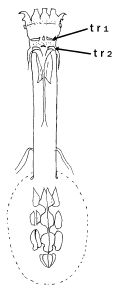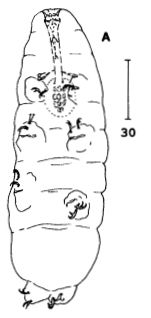Genus description from Pilato et al. 2004: “Genus of family Macrobiotidae; claws of hufelandi type; bucco-pharyngeal apparatus a variant of the Macrobiotus type; buccal tube rigid with ventral lamina; mouth terminal with 10 peribuccal lamellae. Double system of transverse ridges present in the caudal portion of the buccal cavity. Anterior system has no homology with structures known in the other genera of eutardigrades. Posterior system homologous with unique system of transverse ridges present in many genera.”



Citations:
Pilato G, Binda MG, Lisi O. 2004. Famelobiotus scalicii, n. gen. n. sp., a new eutardigrade from Borneo. New Zealand Journal of Zoology. 31: 57-60.















